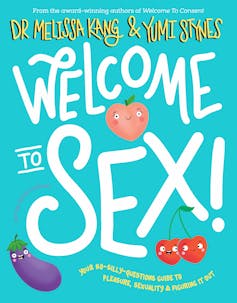Big W has withdrawn Welcome to Sex from its stores to protect staff – but teen sex education can keep young people safe
- Written by Emma Whatman, Subject Coordinator in Gender Studies, The University of Melbourne
 The most recent debate is over Dr Melissa Kang and Yumi Stynes’ Welcome to Sex: Your no-silly-questions guide to sexuality, pleasure and figuring it out[1], which has been withdrawn from sale at Big W[2] stores this week, after “multiple incidents of abuse” of its staff by angry critics of the book. However, Big W “stands by” Welcome to Sex, which it calls “educational, age-appropriate and inclusive”. The department store will continue to sell it online.
Two sides to the debate are playing out.
One side argues[3] the book is a graphic sex guide that’s “teaching sex” to young children. Critics have taken particular issue with small sections of the book that address inclusive sexual practices beyond penetrative sex, including “fingering”, “oral sex”, “scissoring”, and “anal sex”.
They are also critical of the inclusion of what they term “gender ideology[4]”. Others are accusing the authors of “grooming[5]” children – a term that is increasingly misused[6].
The other side is celebrating Welcome to Sex for providing comprehensive and inclusive sex education. Many are saying[7] they wish they had access to this kind of book growing up.
The book describes itself as a “frank, age-appropriate introductory guide to sex and sexuality for teens of all genders […] inclusive, reassuring and all about keeping sex fun, real, and shame-free”.
I am a researcher on texts for young people that deal with issues around sex, sexuality and gender. With my colleague, Dr Paul Venzo, we have been examining the rise of (and demand for) books that provide an inclusive, safe and engaging way to discuss the essential topic of sex for young people.
Sex education books aren’t new
Sex education books for young people aren’t new. Non-fiction picture books from the 1970s like Peter Mayle’s Where Did I Come From?[8] (1973) and What’s Happening to Me?[9] (1975) began the trend of introducing young people to sex in direct and detailed ways.
Paul Venzo’s research[10] shows there are now more than a thousand sex education books for young people, in English alone.
The most recent debate is over Dr Melissa Kang and Yumi Stynes’ Welcome to Sex: Your no-silly-questions guide to sexuality, pleasure and figuring it out[1], which has been withdrawn from sale at Big W[2] stores this week, after “multiple incidents of abuse” of its staff by angry critics of the book. However, Big W “stands by” Welcome to Sex, which it calls “educational, age-appropriate and inclusive”. The department store will continue to sell it online.
Two sides to the debate are playing out.
One side argues[3] the book is a graphic sex guide that’s “teaching sex” to young children. Critics have taken particular issue with small sections of the book that address inclusive sexual practices beyond penetrative sex, including “fingering”, “oral sex”, “scissoring”, and “anal sex”.
They are also critical of the inclusion of what they term “gender ideology[4]”. Others are accusing the authors of “grooming[5]” children – a term that is increasingly misused[6].
The other side is celebrating Welcome to Sex for providing comprehensive and inclusive sex education. Many are saying[7] they wish they had access to this kind of book growing up.
The book describes itself as a “frank, age-appropriate introductory guide to sex and sexuality for teens of all genders […] inclusive, reassuring and all about keeping sex fun, real, and shame-free”.
I am a researcher on texts for young people that deal with issues around sex, sexuality and gender. With my colleague, Dr Paul Venzo, we have been examining the rise of (and demand for) books that provide an inclusive, safe and engaging way to discuss the essential topic of sex for young people.
Sex education books aren’t new
Sex education books for young people aren’t new. Non-fiction picture books from the 1970s like Peter Mayle’s Where Did I Come From?[8] (1973) and What’s Happening to Me?[9] (1975) began the trend of introducing young people to sex in direct and detailed ways.
Paul Venzo’s research[10] shows there are now more than a thousand sex education books for young people, in English alone.
















